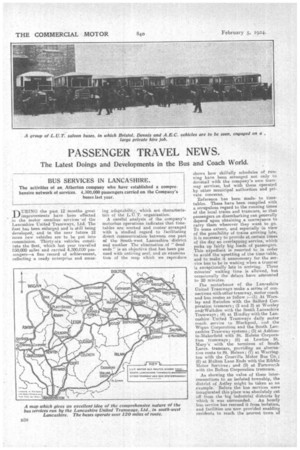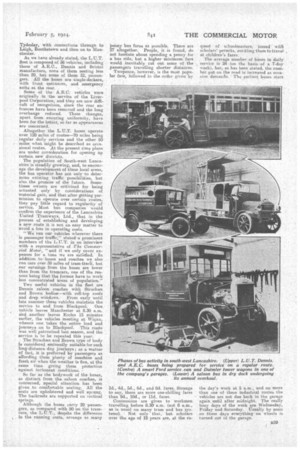PASSENGER TRAVEL NEWS.
Page 22

Page 23

Page 24

If you've noticed an error in this article please click here to report it so we can fix it.
The Latest Doings and Developments in the Bus
and Coach World.
BUS SERVICES IN LANCASHIRE.
The activities of an. Atherton company who have established a comprehensive network of services. 4,300,000 passengers carried on the Company's
buses last year.
DTIRING the past 12 months great • improvenients have been effected in the motor omnibus services -of the Lancashire United •Tramways, Ltd. The fleet has been enlarged and is still being developed, and in the near future 12 more new vehicles are to be put into commission. Thirty-six vehicles constitute the fleet, which last year travelled 850,000 miles and carried 4.300,000 passengers—a fine record of achievement, reflecting a ready enterprise and amaz
ing adaptability, which are characteristics of the L.U.T. organization. A careful analysis of the company's motorbus operations indicates that timetables are worked and routesarranged with a studied regard to facilitating direct communication between one part el the South-west Lancashire district and another The elimination .of dead ends "' is an objective that has been put sued with untiring zeal, and an examina tion of the map which we reprcduve shows how skilfully schedules of running have been arranged not only to dovetail with the company's own tramway services, but with those operated by other municipal authorities and private concerns.
Reference has been madeto timetables. These have been compiled with a scrupulous regard to the running times of the local trains and tramcars, so that passengers on disembarking can generally depend upon obtaining a conveyance to carry them wherever they want to go. To some extent, and especially in view of the possibility of trains arriving late, it is necessary to provide at certain times of the day an overlapping service, which picks up fairly big loads of passengers. This expedient is resorted to in order • to avoid the upsetting of the time-table, and to make it unnecessary for the service bus to be in waiting when a tramcar is exceptionally late in arriving. Three minutes' waiting time is allowed, but occasionally the delaNs have amounted to 20 minutes.
]'he motorbuses of the Lancashire United Tramways make a series of connections with other tramway, motor coach and but routes as follow :--(1) At Woreley and Swindon with the Salford Corporation tramcars; (2 and 3) at Worsley and. WaIkden with the South Lancashire Tramways ; (4) at Hindley with the Lancashire United Tramways daily motor coach service to Blackpool, end the Wigan Corporation and the. South Lancashire Tramway systems ; (5) at Ashtonin-Makerfield with St. Helens Corporation tramways ; (6) at Lou-ton St. Mary's with the terminus of South Lancs. tramcars' providing an alternative route to St. Helens ; (7) at Warrington with the Cresville Motor Bus Co. ; (8) at 'When Lane Ends with the Ribble Motor Services; and (9) at Farnwori-h with the Bolton Corporation tramcars.
As showing the value of these interconnections to an isolated township, the district of Astley might be taken as an example. Before the bus services were inaugurated this place was absolutely cut off from the big industrial districts by which it was surrounded. An hourly bus service has rescued it from isolation, and facilities are now provided enabling residents to reach the nearest town of Tydesley, with connections througe to Leigh, Boothstewn and then on to Manchester.
As we have already statecl,.the L.U.T. fleet is composed of. 36 vehicles, including those of A.E.C., Dennis and Bristol manufacture, none of them seating less -than 29, but some of them 32, passengers. All the buses are single-deckers, with front entrances, and emergency exits at -the rear. .
Some of the A.E.C. vehicles were originally in the service of the Liver pool Corporation, and they are now diffi
cult of recognition, since the rear entrances have been removed and the long
overhangs reduced. These . changes, apart from ensuring uniformity, have been for the better, so far as appearances are concerned.
Altogether the L.U.T. buses operate over 120 miles of routes-70 miles being regular daily services and the other 50 miles what might be described as occasional routes. At the present time plans are under consideration for opening up certain new districts.
The population of South-west Lanceshire'is steadily growing, and, to encour age the development of these local areas,
the bus operator has not only -to deterMine existing traffic possibilities, but
also the premise of the future. Some times owners are criticised for being actuated only byconsiderations of material gain, and that after getting per mission to operate over certain routes, they pay little regard to regularity of service. Most bus companies would • confirm the experience of the Lancashire United narnways, Ltd., that in the process of establishing and developing a new route it is not an easy matter to 'avoid a loss in operating costs. "We run our vehicles wherever there is passenger traffic," stated a prominent members of the L. I.T.T. in an interview
with a, representative of The Commer.6a1 Motor, "and if we only cover ex
penses for a time we are satisfied. In addition to buses and coaches we also run cars over 39 miles of tram-track, but our earnings from the buses are lower
than from the tramcars, one of the reasons being that the former have to work
less concentrated areas of population."
Two useful vehicles in the fleet are Dennis saloon coaches with Strachan and Brown bodies—with roll-top roofs and drop -windows. From early until late summer these vehicles Maintain the
service to and from Blackpool. One vehicle leaves Manchester at 8.30 a.m. and another leaves Eccles 15 minutes earlier, the vehicles meeting at Wigan, . whence one takes the entire lead and journeys on to Blackpool. This route was well patronizedlast season, and the service is to be repeated this year.
The Strachan and Brown type of body is considered eminently suitable for such long-distance day journeys ; as a matter of fact, it is preferred by passengers as affording them plenty of sunshine and fresh air when the weather is fine, at the same time giving them protection against inclement conditions.
So far as the bodywork of the buses, as distinct from the saloon coaches is
conclerned, ;special attention has been given to comfortable seating. All the seats are upholstered and well spiung. The backrests are supported on vertical springs.
Although the buses carry 29 passengers, as compared with 80 on the tram cars, the L.U.T., despite the difference , in the running costs, arrange as many Penny bus fares as possible. There are 27 altogether. People, it is found, do not hesitate about spending a. penny for a bus ride, but a. higher minimum fare would inevitably cut out some of the passengers travelling tihotter distances. Twopence, however, is the most popular fare, followed in the order given by
3d., 4d., 5d., 6d., and 8d. fares. Strange to say, there are more one-shilling fares than 9c1., 10d., or lid., fares.
Concessions are given to workmen travelling, before 8.30 a.m. (not 8 a.m., as is usual on many tram and bus systems). Not only that, but scholars over the age of 12 years are, at the re quest of schoolmasters, issued • with scholars' permits, entitling -them to travel , at children's fares.
The average number of buses in daily service is 24 (on the basis of a 7-day week), but, as has been stated, the number put en the road increased as occasion demarlils. The earliest buses start
the day's work at 5 a.m., and on more than one of these industrial routes the vehicles are not due back in the garage again. until after midnight. The really busy days of the week are Wednesday, Friday and Saturday. Usually by noon on these days everything on wheels is turned out of the garage.
The buses carry passengers' luggage when there is sufficient accommodation. Parcels up to 21 lb. are carried free; parcel of 25 lb. to 35 lb. are charged 2d., and 35 Ils. to 56 lb. 4d. A first-class maintenance department is run by the company, and an inspection of the garage and workshops of the L.U.T. at Atherton reveals the highest efficiency in all departments. Ford service vans with a full kit of tools" and equipment are kept in the garage ready to take to the road at any time, should a vehicle need assistance. Drivers of all L.U.T, coaches and buses are warned that if any repairs cannot be executed within reasonable time on the roadside, they must telephone to the garage for assistance.In the end, this saves both time and trouble. .
The company's rules and regulations always impress it upon drivers that the garages at Atherton, Eccles and Liverpool are available at any hour of the day or night, and they must never take " no reply" from an operator, but persist with the call until communication is established.




























